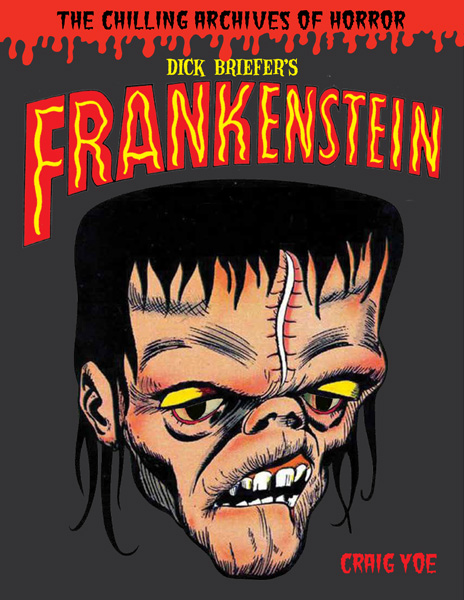Dick Briefer’s Frankenstein
Reviewed by JT Lindroos 25-Nov-10
If this book, the first volume in IDW’s “Chilling Archives of Horror Comics”, is any indication of what the future holds in store, we’re in for a treat. This gorgeous large-size hardback is priced to be affordable, loaded with wonderful artwork, printed beautifully and selected appropriately to showcase all the different faces of Dick Briefer’s adaptation of Mary Shelley’s Frankenstein.
If this book, the first volume in IDW’s “Chilling Archives of Horror Comics”, is any indication of what the future holds in store, we’re in for a treat. This gorgeous large-size hardback is priced to be affordable, loaded with wonderful artwork, printed beautifully and selected appropriately to showcase all the different faces of Dick Briefer’s adaptation of Mary Shelley’s Frankenstein.
Dick Briefer was born in Manhattan in 1915. Like Jack Kirby and Bob Kane, Briefer started his comics career under the wings of Will Eisner and Jerry Iger. His first published work dates to 1936, and his first noteworthy contribution was an adaptation of Victor Hugo’s Hunchback of Notre Dame, from two years later. That rather free adaptation of a classic fell short of being a masterpiece, but it showed promise. Briefer had had some formal art education and he was more than willing to learn his trade.
Where this book picks up is from a 1940 issue of Prize Comics, where Briefer’s freewheeling Shelley adaptation was originally introduced.
The first episode is a skewed retelling of the novel. The drawings are a bit on the crude side and the compositions are hardly original, but whenever Briefer’s pen sketches his creepy monster, the frame comes alive. The characterization of the creature is adventurous and evocative, and when we see our antihero climb on the back of a charging elephant, it literally and figuratively reaches new heights. This offbeat opening has moments of somewhat clumsy grandeur, but I’m happy it was included in the book simply for the sake of setting up the story, and showing the full range of Briefer’s decades-long ‘affair’ with the monster.
Two more early episodes follow, both with some amusingly unsettling set pieces worthy of a Tod Browning picture show: Dr. Frankenstein visits a life-size wax representation of his unholy creation in a sideshow circus, only to find that the real looking corpses inside the glass cage have in fact been freshly mutilated by our fearsome protagonist for the good doctor’s viewing pleasure. Other oddly moving scenes follow, and the cumulative effect of the book is much greater than the devilish details.
A few years later, from mid to late 40s the character took a more humorous approach, which – while taking some of the edge off the comic – also provides it with a substantial increase in both heart and soul. Our scary monster becomes lovable through bolder, if equally odd, story lines and a significant improvement in the artwork. Briefer’s lines become fluid, malleable and increasingly expressive. He hits his stride here, and sustains it through the rest of the book, even when we return to another, less humorous version, of the monster.
Overall I cannot judge the book beyond its content — I can’t say whether these are indeed the best stories available from Briefer’s pen, having read none beyond these covers — but regardless this is a superbly entertaining book, full of gorgeous art produced by a relatively unknown master. The wide variety of controlled tones and styles within these covers speak volumes of the abilities of Dick Briefer. Editor Craig Yoe and his IDW crew are to be commended for making this work available in such a lovingly crafted package, at an affordable price. Based on this first volume I have the highest of hopes for this series.
Tags: Dick Briefer, Frankenstein, IDW